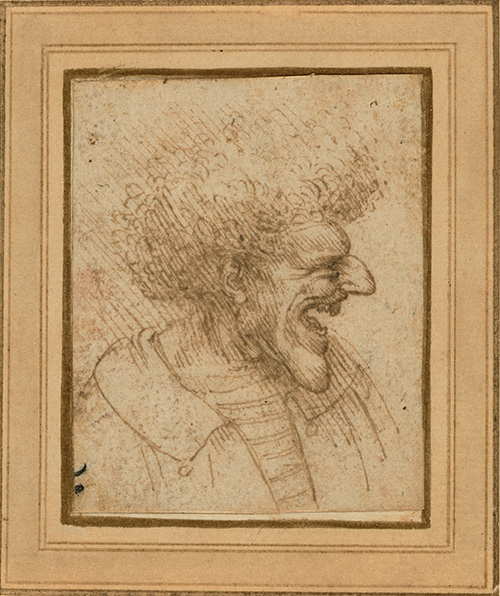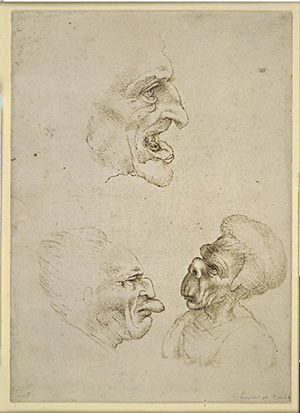Renaissance Symbols Easy Drawings Renaissance Easy Drawings
Look closely at a drawing by Leonardo da Vinci and you'll find telltale signs of his left-handedness

Caricature of a Man with Bushy Hair, about 1494, Leonardo da Vinci. Pen and brown ink, 2 5/8 x 2 1/8 in. The J. Paul Getty Museum, 84.GA.647
Leonardo da Vinci was an anatomist, architect, botanist, engineer, mathematician, painter, scientist, sculptor, and theoretician. And mancino…Italian slang for "lefty." While the historical biases and slurs against left-handers—sinister, gauche, and so on—run through my mind, I confess that what I first think of when it comes to left-handedness is Ned Flanders's Leftorium on The Simpsons.
Leonardo was one of the greatest draftsmen in history, and his handedness left a little-known trace in his drawings: the slope of his lines.
How does the angle of a line indicate whether an artist is left- or right-handed? Well, imagine that you're asked to shade in a square on a sheet of paper with hatching, or closely set parallel lines. If you're right-handed, you'll probably draw strokes from the top right of the sheet to the lower left. If you're left-handed, you'll probably sketch lines from top left to lower right. The hatched parallel lines Leonardo used to shade and render his designs slope precisely this way.
The result can be seen in one of the smallest drawings in the Getty Museum's collection (shown above), which is also one of the best known. It's about half the size of an iPhone, but is an unforgettable image.
Leonardo generally grouped a number of such "physiognomic expressions," portraying extremes of expression and facial features, on a single sheet of paper. The Getty example above was likely cut at an early date from a larger sheet; we don't know when.
From the weight of the ink, we can see how the parallel lines that give shadow to the crazy hair were begun at the bottom and traveled upwards, tapering at the ends. Others surrounding the chin were started on the profile and drawn downwards, as shown by the hook returns at the bottom. But they all slant in the same direction.

Caricature of a Man with Bushy Hair (detail), about 1494, Leonardo da Vinci. Pen and brown ink, 2 5/8 x 2 1/8 in. The J. Paul Getty Museum, 84.GA.647
Leonardo's left-handedness has come to be regarded as something of a signature, but he was not, of course, the only left-handed artist in the Renaissance. Indeed, according to contemporary sources Michelangelo was innately left-handed but retrained himself to write and draw right-handed, the fate of many lefties of history.

Three Caricature Heads with Grotesque Features, 1467–1519, unknown artist after Leonardo da Vinci. Pen and brown ink, 18.5 x 13.3 cm. Image © Trustees of the British Museum
Leonardo's physiognomic drawings were reasonably well known even during his own lifetime. After he died in France in 1519, they were bequeathed to his pupil Francesco Melzi, who took them back to Milan. Melzi made them available to other artists to study, many of whom, even though they were right-handed, copied the drawings with left-handed hatching to reproduce the original look. To do this they likely turned their own sheets of paper as they drew, but some of the copies were more successful than others.
This drawing in the British Museum includes copies of three of Leonardo's sketches and quite effectively renders his technique, with long strokes and repeated hook returns.
A drawing in the Metropolitan Museum, which studies only one of Leonardo's physiognomic heads, is much less successful, resulting in what esteemed Renaissance scholar Carmen Bambach charmingly described as a "salad of short lines." (If you're interested in the subject of Leonardo and left-handedness do read her essay on the subject in the comprehensive 2003 catalogue Leonardo da Vinci: Master Draftsman, pages 31 to 57).

The Head of a Grotesque Man in Profile Facing Right, after 1500, unknown artist after Leonardo da Vinci. Pen and brown ink, 3 5/8 x 2 1/8 in. The Metropolitan Museum of Art, Rogers Fund, 1917. 17.142.3. www.metmuseum.org
Most of these copies were made by young artists simply learning to draw—it was common to practice by copying the masters. But some of them were no doubt intended to be passed off as original drawings by Leonardo, a practice that has continued through the ages. A forgery in the British Museum's collection, for example, dates from the early 1900s.
Leonardo da Vinci's left-handedness is one of the wonderfully distinctive aspects of his draftsmanship, but it is not always prominent. After about 1500 he began to seek more tonal effects that rendered his hatched lines less obvious. With careful observation, however, the left-handedness is almost always apparent. It is a sad fact that during my ten-plus years at the Getty we have more than once been offered drawings for sale that were claimed to be by Leonardo, but were clearly the product of right-handed artists.
To see close-ups of right-handed parallel hatching, have a look at the short slideshow for the exhibition Hatched! Creating Form with Line.
Source: https://blogs.getty.edu/iris/leonardo-da-vinci-renaissance-lefty/
0 Response to "Renaissance Symbols Easy Drawings Renaissance Easy Drawings"
Post a Comment